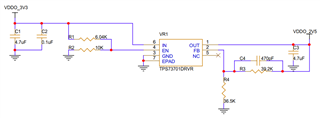- Ask a related questionWhat is a related question?A related question is a question created from another question. When the related question is created, it will be automatically linked to the original question.
This thread has been locked.
If you have a related question, please click the "Ask a related question" button in the top right corner. The newly created question will be automatically linked to this question.
Hi TI experts,
The design of TPS73701DRVR is shown below.

When TPS73701DRVR is powered off, the slow discharge of the Vout resulting a issue that the Vout is higher than the Vin.
Will this issue affect the chip, such as potentially impacting its performance or causing damage to the chip?
Or at what point does Vout being greater than Vin potentially cause issues?
Thanks
Hello,
There is a risk that there will be a reverse current condition. Typically, as long as this stays below 5% the rated current, this should not affect the device.
Are you able to add a resistive load in parallel to the current load? This could potentially fix your issue.
Best,
Juliette
Hi Juliette,
Thank you for helping to analyze and solve this problem.
About reverse current of TPS73701, the datasheet explains as follows.

According to the description in the datasheet 6.3.4:
1、When the EN pin is driven low, there is no reverse current;
2、But at the end of Section 6.3.4, it is mentioned that “reverse current can flow when VFB is more than 1.0 V above VIN”.
That is to say, as long as VFB>(Vin+1.0V), reverse current will be generated, regardless of whether EN is pulled low or not.
Is the above understanding completely correct?
In our design, Vin=3.3V, Vout=2.5V, and during our power-off testing, it was found that Vout is 1.7V larger than Vin at maximum, equivalent to VFB is 0.82V larger than Vin. According to the datasheet 6.3.4, there should be no reverse current generated.
Please help review the above statement to see if there are any issues.
Thanks
That is to say, as long as VFB>(Vin+1.0V), reverse current will be generated, regardless of whether EN is pulled low or not.
Yes.
There seems to be a sequencing requirement, so VEN has to be pulled low before VIN to be guaranteed that there will be no reverse current.
In your application, however, because you're only seeing 0.82V, you should not have a reverse current condition.
Best,
Juliette